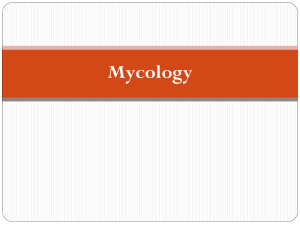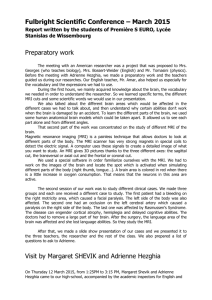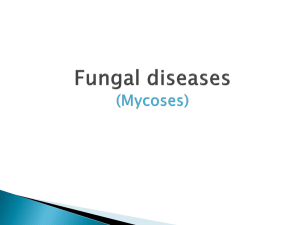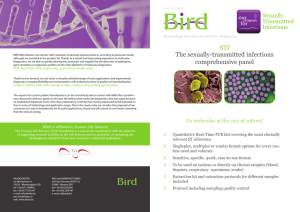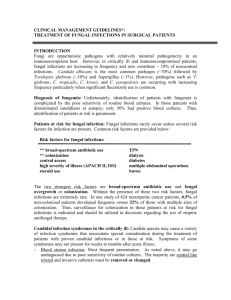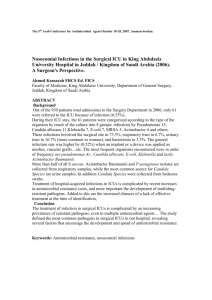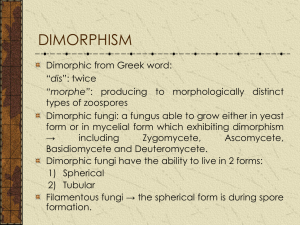- Worcester Research and Publications
advertisement
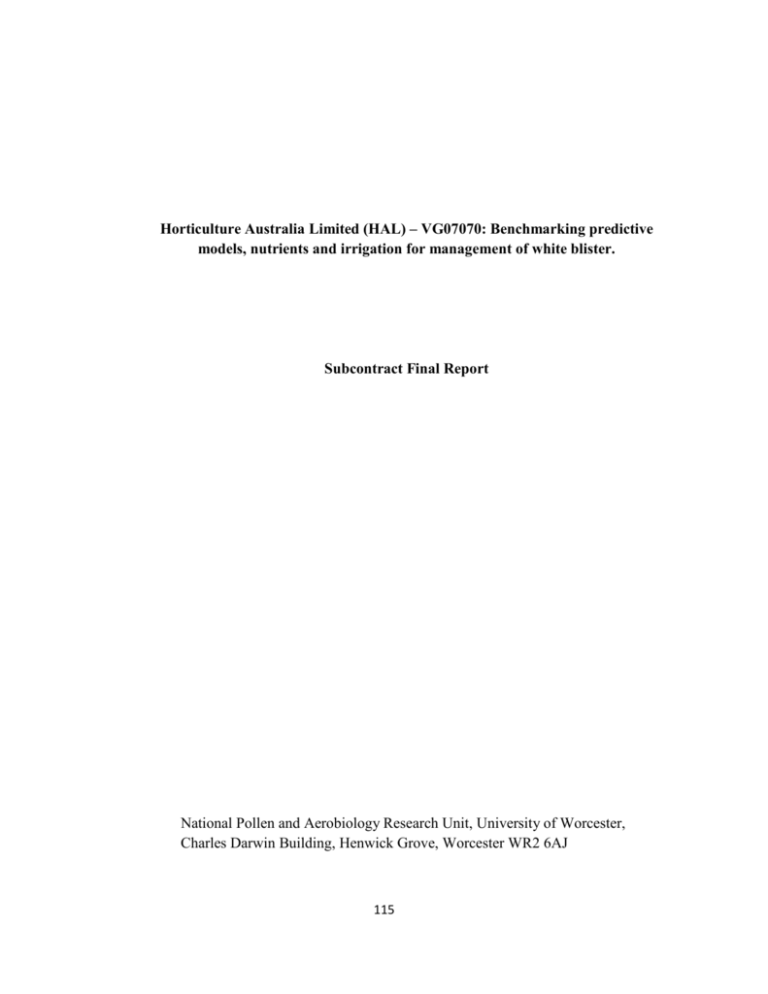
Horticulture Australia Limited (HAL) – VG07070: Benchmarking predictive models, nutrients and irrigation for management of white blister. Subcontract Final Report National Pollen and Aerobiology Research Unit, University of Worcester, Charles Darwin Building, Henwick Grove, Worcester WR2 6AJ 115 Project title: Horticulture Australia Limited (HAL) – VG07070: models, Benchmarking nutrients and predictive irrigation for management of white blister. Project leader: A.Wakeham, National Pollen and Aerobiology Research Unit, University of Worcester, Henwick Grove, Worcester WR2 6AJ Technical support G. Keane Report: Final report Previous report: N/A Location of project: University of Worcester Date project completed [20thNovember, 2011] (or expected completion date): 116 Report Contents Project Background YEAR 1 Production of Monoclonal Cell Lines Introduction Methods Results Discussion Reactivity of selected Monoclonal Antibodies Introduction Methods Results Discussion Competitive lateral flow development Introduction Methods Results Discussion Summary 4 5 5 5 7 8 8 8 10 11 11 12 12 12 13 14 14 YEAR 2 Monitoring airborne spores of Albugo candida in commercial Brassica crops in Australia using aerial spores. Introduction Methods Results Discussion Development of a lateral flow field test for quantification of A. candida in air samples. Introduction Methods Results Discussion Test predictions using the developed lateral flow kits for within and between crop spread of white blister inoculums in UK fields trials. Introduction Methods Results Discussion Project Summary Literature cited 16 16 16 19 21 21 21 22 22 22 23 23 24 25 26 26 28 117 PROJECT BACKGROUND White blister is caused by the oomycete pathogen Albugo candida and is a common disease of many economically important cruciferous vegetables and oilseed crops. Significant yield losses from this disease have been reported on the oilseeds B. rapa and B. juncea and, to a lesser extent, on susceptible lines of B. napus. Affected vegetables include broccoli, Brussels sprouts, cauliflower, radish, mustard, Chinese cabbage and turnip. The impact of disease in these crops is of a cosmetic nature and can render crops unmarketable. In Australia the disease has been commercially important in vegetable production since 2002 To date, more than ten distinct biological races of A. candida have been identified and classified based on host specificity. The recorded pathotypes in Australia are likely to be Races 1, 2, 3,4, 5, 6, 7, 9 and 10. Race 9 infects B. oleracea and is considered to have caused the recent outbreaks of white blister on broccoli in Australia. Current broccoli varieties tolerant to white blister are not available all year round. Disease management strategies to control the disease include routine spray programs alongside improved irrigation scheduling. In the UK, improved management of the disease and, reduced applications with effectiveness of the fungicides applied, has been achieved utilizing information from an environmental white blister disease risk forecast. This system is currently being trialed in Australia. The present study aims to improve the environmental white blister disease risk forecast by including information on availability of A. candida airborne disease inoculum. Monoclonal antibodies, with recognition sites to A. candida Race 9 zoosporangia, will be produced and assessed within a PTA ELISA (plate-trapped antibody enzyme-linked immunosorbent laboratory test) for quantification of MTIST trapped field aerosols of A. candida. Preliminary studies will investigate the potential of an immunological chromatographic test strip (lateral flow) to provide ‘in field’ information on A. candida spores in collected field air samples. 118 YEAR 1 Production of Monoclonal Cell Lines Introduction The white blister pathogen Albugo candida is an obligate parasite which cannot be cultured on agar and will only grow and develop on host tissue. The pathogen can lie dormant by the formation of oospores on contaminated seed, in soil or on infected host material. During favorable periods oospore germination and sporangia production give rise to pustule formation on the host. Zoosporangia are dispersed by wind, rain, or insects to neighboring plants. The zoosporangial stage of the pathogens life cycle was identified for monoclonal antibody production (MAb). Methods Collection of zoosporangia. A hand held Burkard surface cyclone sampler (Burkard Manufacturing Co., Rickmansworth, Herts., UK) was used to collect zoosporangia of A. candida from the leaf surface of sporulating infected B. oleracea host material. One ml of chilled phosphate buffered saline ((PBS) 0.01M phosphate buffer, 0.0027M potassium chloride, 0.137M sodium chloride, pH 7.4) was added to the air sampler collection vessel. Using a spin mix (Gallenkamp Ltd, Cheshire) at high speed for five minutes the zoosporangia were suspended in to the aqueous phase. The spore suspension was filtered through a polyester Spectra mesh membrane (47µm pore size; NBS Biologicals Ltd, Huntingdon, UK) to remove any large contaminating material. The liquid phase was collected and, by using a membrane of 10µm pore size, bacteria and other small leaf contaminants were removed after filtration. The filtrate was collected and resuspended in 2ml chilled PBS and, presence of A. candida zoosporangia confirmed by bright field microscopy (x 400). A zoosporangial concentration of 1x107 ml-1 was determined. Immunogen preparation. Using a Fast Prep 120 instrument (www.qbiogene.com) at an operating speed of 5 for 25 seconds the A. candida zoosporangia were disrupted. The sample was rested on ice for 3 minutes and the process repeated twice. After microfugation in an MSE Microcentaur (www.mseuk.co.uk), operated at 10,000 r.p.m for five minutes, the soluble phase of the disrupted A. candida sample was retained and transferred to a YM30 microcon centrifugal unit (www. millipore .com). The sample was separated in to two fractions of > 30 KDa and < 30 KDa according to manufacturer’s guidelines. The protein concentration of the >30 KDA fraction was adjusted to 2 mg ml-1 and stored at -20°C. Using a mini slide-a-lyzer dialysis cassette of molecular weight cut off 2 KDa (www.thermoscientific.com) the A.candida < 30 KDA fractions 119 was dialysed according to manufacturer guidelines in ½ strength chilled PBS buffer. The protein concentration of the recovered dialysed sample was determined, adjusted to 2mg ml-1 and stored at -20°C. Immunisation. Three Balb C mice were immunized, by intraperitoneal injection, each with 50µl of > 30 KDa A. candida zoosporangia preparation mixed with an equal volume of Titermax adjuvant (Sigma T-2684). An additional three mice were immunized with the < 30 >2 KDa A. candida zoosporangia preparation. The process was repeated monthly over an 8 week period. To determine the immune response of each mouse to the homologous immunogen preparation, tail bleeds (50µl blood sample / mouse) were taken 7 days after the third immunization. Tail bleeds. Using a standard plate-trapped antigen enzyme-linked ELISA (PTA-ELISA) polysorp microtitre wells (Catalogue No. 469957, Life Technologies Ltd, Paisley, Scotland) were each coated with 100µl of 10µg homologous antigen in PBS and incubated overnight at 4°C. The PTA-ELISA was carried as described by Wakeham (2004) but at the primary antibody stage doubling dilutions of each tail bleed were made in PBSTwC (PBS, 0.05% Tween 20 and 0.1% Casein [wt/vol]) to an end point of 1 in 128,000 and, each dilution probed against replicate homologous well-trapped antigen. A Strept ABC complex DAKO duet amplification system, (Cat.No. KO492; DAKO Ltd, Cambridge, UK) was used according to the manufacturers guidelines at the secondary Ab stage. Two weeks later a pre fusion immunogen boost was given, as described previously, to two mice. Mouse 1 received an immunogen preparation of A. candida <30KDa >2KDa and Mouse 6 >30 KDa. Four days later the two mice were killed. Fusion. The spleens of two mice were removed and, for each, a fusion was carried out according to Warwick HRI standard protocol using a modified method of Kennet (1978). Antibody producing B cells isolated from the spleen were fused in vitro with lymphoid tumour cells (myeloma). The cell hybrids (hybridomas) were supported in Dulbecco’s Modified Eagles’s Medium (Code No. D5976, www.sigmaaldrich.com) containing 10% Foetal calf serum (DME). On day 6 100µl DME fresh medium was added to each hybridoma and, the medium changed on day 10. Cell tissue (TCS) culture supernatants were screened by PTA ELISA and immunofluorescence (6) 14 days after cell fusion for the presence of antibodies which recognized zoosporangial epitopes of A. candida. Cell lines which gave a positive results (> 3 times the negative control in PTA ELISA) were selected and twice cloned three times 120 Results Tail bleeds. The two immunogen preparations (A. candida <30KDa >2KDa and, > 30 KDa A. candida zoosporangia soluble antigen) elicited an immune response in each of the mice, producing antibodies that reacted with either A. candida preparation as determined by PTA ELISA (Fig. 1.). Of the two types of immunogen preparation used, Mouse 1 and Mouse 6 were selected for fusion, as each proved optimal in the immune response to its homologous antigen. PTA ELISA Absorbance value (450nm) PTA ELISA >30 KDa A.candida PTA ELISA <30 KDa >2 KDa A. candida 1.6 1.6 1.4 1.4 Mouse 1 Mouse 2 Mouse 3 1.2 1.2 1 1 0.8 0.8 0.6 0.6 0.4 0.4 0.2 0.2 0 0 Mouse 4 Mouse 5 1:50 1:100 1:200 1:400 1:800 Mouse 6 1:1600 1:3200 1:6400 1:12800 Mouse tail bleed dilution Figure 1. Immune response (polyclonal serum) of immunised mice to two A. candida zoosporangia preparations, as tested by PTA ELISA. Fusion. Five cell lines which produced antibodies positive to A. candida by either PTA ELISA or IF were identified from Fusion 1 (Mouse 6 , immunized with >30KDa A. candida) and cloned. The cell lines were coded, the class and subclass determined (Table 1) and, for long term storage, retained in vials in liquid nitrogen at -185°C. Tissue culture supernatants (monoclonal antibodies) of each cell line were stored at -20°C in 250µl lots. Few positive cell hybridomas were identified from Fusion 2 (Mouse 1, immunized with <30 KDa > 2 KDa ) and, each proved unstable during cloning. 121 Table 1. MAb cell lines raised to Albugo candida Fusion Cloned cell line Class 1 4E1 D1 A2 IgM 1 5C5 E2 C4 IgG 1 EMA 257 1 3A10 D2 IgG 1 EMA 258 1 5F1 C10 A4 IgG 1 EMA 251 1 F1 F8 C4 Subclass Code Name EMA 256 EMA260 Discussion From two fusions, five A. candida zoosporangia positive cell lines were identified and cloned. All of the cloned cell lines were from Fusion 1 (mouse immunized with >30 KDa A. candida soluble material). Tail bleeds (PTA ELISA tail bleeds) indicated a strong immune response to A. candida immunogen <30 KDa > 2 KD however post fusion few positive hybridoma cell lines were identified and, during cloning all proved unstable. Additional fusions would be required to determine whether this result was characteristic of the immunogen used. Reactivity of selected Monoclonal antibody cell lines (MAbs) Introduction To determine specificity of the five selected MAb cell lines, the MAbs were screened by immunfluorescence (IF) against selected Albugo candida races and a range of fungal species (Table 2). Where the fungal species was cultivated on host material, spore collection was as described previously, using a hand held cyclone sampler and the spore sample made in to suspension with the addition of PBS. Spore numbers were adjusted to a final concentration of 1 x106 spore ml-1. The remaining fungal species were inoculated on to a synthetic agar medium (Table 2), which had been pre-covered with PN60206 Supor 450 90 mm diameter membrane disc (www.pal.com). Fourteen days after inoculation the membranes were removed, and 5 ml PBS was added to each. Surface washings were taken by gently stroking the surface of the membrane with a sterile glass rod and, retained on ice whilst spore counts were made by bright field microscopy (x 400). Spore numbers were adjusted to a final concentration of 1 x106 spore ml-1. 122 Table 2. Fungal species used to assess reactivity of the five MAb cell lines. Fungal species Code Name/Origin Host / Growth Medium Race Albugo candida UK Cabbage 9 Albugo candida AU03 Broccoli 9 Albugo candida AU04 Broccoli 9 Albugo candida AUO5 Broccoli 9 Albugo candida AU06 Chinese Cabbage 7 Albugo candida AU Pak Choi 7 Albugo candida AU Soi Choi 7 Albugo candida AU Albugo candida AU Radish 1 Albugo candida AU Radish c.v. radar 1 Albugo candida AU15 Broccoli 9 Albugo candida UK Garden weed Albugo candida UK Shepherds purse 4 Albugo candida AU Shepherds purse 4 Albugo candida AU Rocket Albugo laibachii Norway Arabidopsis thaliana Ramularia UK Malt extract agar Fusarium culmorum UK V8 juice agar Puccinia allii UK Onion Green stem Pak Choi c.v. Miyako Oideum neolycopersici UK Tomato Erysiphe cruciferarum UK Brussels sprout Hyaloperenospora Lettuce UK brassicae 123 7 Fungal species Code Name/Origin Host / Growth Medium Bremia lactucae UK Lettuce Pyrenopeziza brassicae UK Brussels sprout Botrytis cinerea Potato Dextrose Agar UK Stemphylium botryosumAU Agar Cladosporium AU Agar Alternaria alternata AU Agar Phoma lingam AU Agar Race cladosporioides Methods Microwells of a 29 Teflon coated 6 multiwell (8 mm diameter) glass slides (Code 63423-08, Electron Microscopy Services, Hatfield) were each coated with 30µl poly-l-lysine (Code No. Sigma P-1524 www.sigmaaldrich.com) in PBS (1mg ml-1). Following a 10 minute incubation period at 18 to 20°C the slides were rinsed in distilled water and air-dried under a constant airflow. To each well of a coated multiwell slide, 30µl of a fungal suspension was aliquoted and, retained in a humid environment for a 12 hr period. The glass slide was removed and allowed to air dry overnight. The slide was rinsed in PBS and air dried in a laminar flow cabinet. Tissue culture supernatants of each MAb cell line (Table 1) were diluted 1:2 in PBSTwc and, each applied at a rate of 30µl to a multiwell. The sixth well received PBSTwC alone. The slide was incubated for a period of 30 mins at 18 to 20°C in a moist chamber. The slide was gently rinsed with PBS and air-dried as described previously. 30µl of anti-mouse (whole molecule) fluorescein isothiocyanate conjugate (Cat. No. F-0527 www. sigmaaldrich.com) diluted 1:60 in PBSTwC Evans blue counterstain (6) was then aliquoted to each well and, incubated as previously described, in darkness. The slide was then rinsed, air dried in darkness and mounted in DAKO fluorescent mounting medium (Code no. S3023 www.dako.co.uk). This process was repeated for each of the fungal species listed in Table 2. The slides were viewed under U.V. with a fluorescent microscope using selective fluorescein excitation at wavelength 490 and a barrier filter at 520 wavelength. 124 Results Each of the MAb cell lines bound to epitope sites present on the zoosporangial wall of Albugo candida race 9 (Plate 1a) and, to A. candida zoosporangia isolated from a garden weed (Plate 1b). Initial studies suggest that EMA 256 is A. candida species and is races specific, binding strongly to Races 9 and 1 and weakly to Race 4 and 7. All other fungal species and A. candida races tested (Table 2) were negative by IF. EMA 258 gave a similar profile but did not react with Race 4 or 7. Nevertheless, some recognition by EMA 258 was observed to the germ tube of Erysiphe cruciferarum. With the exception of EMA 256, each of the MAbs bound to epitope sites on the germ tube of E. cruciferarum. EMA 259 to the conidial stage. No reactivity to the other fungal species tested was observed (Table 2). Only EMA 257 reacted with A. candida zoosporangia isolated from Rocket (Eruca sativa). Plate 1. A. candida zoosporangia labelled with EMA 256 conjugated to a fluorescein anti-mouse label as viewed by fluorescence microscopy (x 400) Discussion None of the cell lines selected proved A. candida race 9 specific. However MAb cell lines EMA 256 and 258 exhibited a level of specificity that may prove useful in the development of a rapid field based test for monitoring epidemiological significant levels of airborne inoculum of A. candida, in horticultural areas of Australia. Of the five MAbs, four bound to epitopes present on the germ tube of Eryisphe cruciferarum (Brassica powdery mildew), however no recognition to 125 Oidium neolycopersici (tomato powdery mildew) was observed. Additional studies could look to determine whether these MAb recognition sites relate to a protein / structure involved in the infection process / immune response of the host. Competitive Lateral flow development Introduction The technical basis of the lateral flow immunoassasy test (lfd) was derived from the latex agglutination assay (11). However establishment of the technology for the lateral flow test was not available until the late 1980’s. Pioneering work in the development of a ‘home test’ for determination of human pregnancy assisted this technology to the wider market place, enabling complex laboratory processes to be carried out on-site by non-laboratory personnel. The simplicity of the design, requiring addition only of the sample and the compact and portable capability of the test, make it popular for development of a wide range of assay tests. The application of these tests has expanded beyond clinical diagnostics to areas as diverse as veterinary, agriculture, bio-warfare, food, environmental health and safety, industrial testing, as wells as newer areas such as molecular diagnostics and theranostics. Different configurations of the lateral flow assay exist however all require the basic elements of a solid membrane phase, a fluid transport and, a test specific labelled antibody. For the purpose of this work, a competitive lateral flow assay format was used to develop a prototype field test for semi-quantification of trapped airborne inoculum of A. candida. A competitive lateral flow device (clfd), in the absence of a target sample (A. candida zoosporangia), will give rise to the formation of a test line. Rate of test line depletion will relate directly to target levels in the test sample. In the competitive format, the test line depletion is generally measured using a portable optical device. Methods Lateral flow construction. Competitive lateral flows (clfds) (Fig. 2), comprising a Millipore 180 HiFlowTM cellulose ester membrane direct cast onto 2ml Mylar backing (Millipore Corp, USA), an absorbent pad (www.whatman.com), sample pad (www.millipore.com ) and a filter pad (www.whatman.com ) were constructed for the detection of A. candida zoosporangia. A control line of an anti-mouse serum at 0.5 mg ml -2 (www.sigmaaldrich.com) was sprayed directly on to the membrane surface using a flatbed air jet dispenser (Biodot Ltd,West Sussex, UK) at a constant rate of 50 m/s. A collected soluble fraction of an A. candida zoosporangial sample was adjusted to 0.5 mg ml-1 in ¼ strength PBS and applied as a test line to the membrane surface, as previously described. Membranes were air-dried overnight at 18 to 20° C and 126 sectioned in to 5mm strips before being individually housed in a plastic case (Advanced Microdevices, Ambala, India). A 5µl gold anti-mouse IgM solution (Code BA GAMM 40, British Biocell International, Cardiff, UK) was pre-mixed with 30µl EMA 256 (Lot 1 diluted 1 in 50 conjugate buffer) before application to a pre-cut 5mm conjugate pad ( www.millipore.com). The conjugate pad was laid horizontal and air-dried at 35°C for a period of 10 mins (or until dry). After which the conjugated antibody pads were stored individually in non-stick 0.5ml microfuge tubes. Laminate backing card Figure 2. Control line Sample pad Test line Conjugate pad Absorbent Pad Lateral flow cross section (5mm strip) Lateral flow test. Ten fold dilutions of 1x108 to 100 A. candida zoosporangia (race 9) were prepared in Warwick HRI PVPC buffer. To 0.5ml non-stick microfuge tubes, each of which contained a pre prepared gold conjugate pad, 100µl aliquots of the zoosporangia dilution series were dispensed. Following a 1 minute incubation period to rehydrate the gold conjugated MAb, the contents of the microtube were mixed and transferred drop wise to a competitive lateral flow device (clfd). After 10 minutes the clfds were observed visually for the development of a control and test line. The test line area of each clfd was electronically measured using a Quadscan device (BioDot, Chichester, UK). Results With the exception of A. candida suspensions at 1x108 and 1x107 zoosporangia ml-1, test and control lines were observed on each of the competitive lateral flow strips (clfd). Electronic readings of the test line area however showed a correlation (r2=0.9777) (Fig.3) between the optical density of the test line area and the A. candida zoosporangia suspension applied to the clfd. 127 Figure 3. Change in lateral flow test line optical density with A. candida concentrations in test samples. Discussion The developed competitive lateral flow device enabled quantitative readings to be made of A. candida zoosporangia numbers when an electronic reader device was used. However test visual readings only enabled samples in excess of 1x 106 zoosporangia ml-1 to be identified. Further work will be carried out to optimize the assay format to increase visual test sensitivity whilst retaining good discrimination using an electronic reader. A competitive lateral assay format will be assessed in Year 2 using EMA 258 labelled to a gold carrier. Summary In Year one of the study five MAbs have been raised to zoosporangial material of A. candida. Reactivity tests have determined that two of the MAb cell lines may exhibit a level of sensitivity and specificity that could prove useful in a developed field test system. A competitive lateral flow prototype (clfd) has been developed using cell line EMA 256 and this will now be extended 128 to include EMA 258. However, the studies to date have demonstrated that in the present format for the test to be useful, quantitative readings would need to be made using a Quadscan device. In this format a calibration series of A. candida zoosporangia concentrations would be a requirement of the test and run concurrently with field samples to determine quantitative information on A. candida field trapped zoosporangia numbers. Future work will investigate the optimization of the assay format to enable visual clfd discrimination of trapped A. candida airborne inoculum that would give rise to disease development when under optimal environmental conditions. This may preclude the need for an electronic reader and an A. candida zoosporangial calibration test series. 129 YEAR 2 Monitoring airborne spores of Albugo candida in commercial Brassica crops in Australia using aerial spore traps. Introduction Accurate information about the presence of sufficient disease is required to predict plant disease occurrence in field settings (12). Traditionally, plant disease forecasting systems have relied upon environmental data singularly to predict disease occurrence in crops (9,12). Mathematical models describing the effect of temperature and wetness on pathogen infection have been developed for many types of plant pathogen. Magarey (2004) provides a comprehensive review of these systems. However, detecting and quantifying airborne spores could augment disease forecasting systems. By determining airborne spore numbers during a time period when environmental risk for a disease is high, and when protective disease control strategies could be implemented. This study reports on monitoring airborne inoculum of Albugo candida in commercial Brassica crops in Australia using air samplers placed within the crop canopy. Commercial Broccoli crops c.v. Ironman and Steel, located on a property at Cunninghams Rd, Werribe, South Victoria were monitored for airborne disease transmission events of Albugo candida for two, two month periods between May 2010 and December 2010. Another commercial Broccoli crop c.v. Viper located on a property at O’Conners road, Werribee South Victoria was also monitored for airborne disease transmission events by Albugo candida for a further 2 month period in January-February 2011. Three air samplers: a Microtitre immunospore trap (MTIST), a volumetric 7 day sampler and a multi-vial cyclone air sampler, were operated within the cropping system. An environmental white blister disease forecast model was evaluated for use in determining periods of white blister risk. Methods Monitoring airborne disease transmission of Albugo candida in a commercial Broccoli cropping system using three air samplers Microtitre Immunospore Trap (MTIST). A detailed description of the MTIST device, which is manufactured by Burkard Manufacturing Company (Rickmansworth, Herts, UK) can be found in Kennedy et al., 2000 (7,15). In the outdoor version air is drawn thorough a manifold consisting of a plastic tube with a right angle bend placed over the sampler inlet. The manifold samples air through a 9cm diameter vertical circular inlet and directs it into the sampler body that is held horizontally. For field use, the sampler (including the manifold) is mounted on a wind 130 vane so that the manifold inlet faces into the wind. Within the sampler the airflow is channeled through 32 trumpet shaped nozzles each directed at the base of a microtitre well. The sampler contains four microtitre strips each containing 8 wells. The MTIST air sampler uses a suction system and particulates in the airstream are impacted on the base of each collection well of the four microtitre strips. The collected impacted target particulates may, if appropriate antibodies are available, be immunoquantified by plate trapped antigen enzyme-linked immunosorbent assay (PTA-ELISA). Monitoring A. candida spores in MTIST collected field aerosols . An MTIST spore trap was placed within a commercial field Broccoli crop. Held within the base plate of the machine were four coated eight well microtitre strips (0.1mg ml-1 Poly-L-Lysine (Sigma P-1524) in distilled water and sodium azide (Sigma S-2002). The MTIST spore trap was operated for 12H periods from 06:00 H to 18:00 daily. The coated microtitre strips were changed daily and prior to analysis stored at -20oC. Enumeration of MTIST trapped A. candida spores. Visual examination of the base of field exposed microtitre wells determined that a high concentration of air particulates would prevent accurate enumeration of A. candida spores. The wells of two, eight well strips of each field sampling period were processed by PTA ELISA (7). Field trapped A. candida spores were identified and labelled using a monoclonal antiserum (MAb EMA 256). This process was amplified using an anti-mouse biotinylated conjugate linked to a streptavidin horseradish peroxidase system (Dako K-0492) and visualised by adding 100µl to each microtitre well of 3,3’,5,5’-tetramethylbenzidene substrate (Sigma T-3405 and P-4922). The reaction was stopped by adding 25µl of a 20% 1M H2SO4 solution and the generated absorbance values were read at 450nm using a Biotek ELISA plate reader (EL800). This process was repeated using the remaining field exposed microtitre strips in conjunction with MAb EMA 258 (raised to A. candida) used in the assay format. Burkard 24hr Volumetric glass slide air sampler A Burkard 24H volumetric air sampler which contained a glass slide coated with silicone (BC 380S, Basildon Chemical Co, Kimber road, Abingdon, Oxon, UK) operated at an air flow of 10 L of air per minute. Sampled air particulates impacted directly on to an area of the glass slide which corresponded to time intervals by movement of the glass slide over a 24 H period. Monitoring A. candida spores in collected field air samples. The Burkard 24H glass slide volumetric spore trap was placed 2 m from and adjacent to the MTIST spore trap. The trap was loaded daily with a silicone coated glass slide and air particulates were impacted directly on to the surface. The glass slide was changed daily after 18:00 H and stored at -20⁰C. Enumeration of trapped A. candida spores. Each glass slide was examined for the presence A. candida spores by bright field microscopy. 131 Burkard multi-vial cyclone air sampler. The characteristics of a cyclone air sampler are described by Ogawa & English (1995). Air is drawn through the sampler using a vacuum pump in the form of a cyclone. The height of the cyclone and air inlet, along with the width of the air inlet, air exhaust diameter and the diameter of the cyclone within the length of the exhaust pipe influence the relative efficiency of the trap. These characteristics have been drawn together and standardised within the Burkard cyclone sampler (Burkard Manufacturing Co.). The cyclone air sampler operates at an air flow rate of 10 to 15 L air / min. Monitoring A. candida spores in collected field air cyclone samples. The multi- vial cyclone spore trap was placed 2 m from and adjacent to the MTIST spore trap in the commercial Broccoli field crop. The trap was loaded weekly with eight 1.5ml microfuge tubes (Sarstedt 2013/4). By an integrated automated mechanism each tube was exposed once for a 12 H period for collection of field air particulates. Each sampling exposure period was between 06:00 to 18:00 H daily. After each eight day period the field exposed tubes were collected and stored at 20⁰C . Enumeration of trapped A. candida spores. To each exposed microtitre tube 100µl of NPARU B2 buffer was added and agitated using a Gallenkamp Spin Mix for 5 seconds at high speed. A lateral flow device developed for field assessment risk of the white blister pathogen was identified to semi-quantify trapped airborne disease inoculum of A. candida. A 100ul aliquot of the spore suspension was applied to the sample pad of the lateral flow device (Plate 2A) and test line development was assessed 15 min. later using an ESE Quant reader (Plate 2B). Plate 2. A lateral flow device for evaluation of field crop risk to white blister (A) and a hand held reader (B). Control line Test line A B 132 Results Microtitre Immunospore Trap (MTIST). The PTA ELISA carried out on the field exposed wells for the sampling periods May - June 2010, November - December 2010 and January February 2011 identified periods of when the Broccoli crops were at risk to infection by A. candida (Fig. 4). Low level disease potential by MTIST PTA-ELISA was determined within the May – June, 2010 sampling period. During November and December 2010 a high risk period was noted between 19th- 21st November 2010. A number of moderate risk periods were identified throughout the period (Fig. 4). For the third field sampling phase the Broccoli field crop was determined to be at low level risk A. candida until the end of January. A high risk period was then identified in the middle of February 2011. Each field exposure period was monitored for white blister disease transmission using two different A. candida specific monoclonal antibody cell lines. Both exhibited a similar response pattern but with EMA 258 providing an enhanced signal. However this may be due to the activity used as EMA 258 was optimised at 1:2 whereas EMA 256 is used at a 1:200 dilution. MTIST ELISA PTA reading 1.8 1.6 1.4 1.2 1.0 0.8 0.6 MTIST EMA 258 0.4 MTIST EMA 256 0.2 17-18/01/2011 19-20/01/2011 21-22/01/2011 24-25/01/2011 26-27/01/2011 28-29/01/2011 31-02/02/2011 03-04/02/2001 07-08/02/2011 9-10/02/2011 11-14/02/2011 15-18/02/2011 21-22/02/2011 23-24/02/2011 25-26/02/2011 06-07/11/2010 08-09/11/2010 10-11/11/2010 12-13/11/2010 14-15/11/2010 17-18/11/2010 19-21/11/2010 22-23/11/2010 25-26/11/2010 27-28/11/2010 29-30/11/2010 01-03/12/2010 03-04/12/2010 05-06/12/2010 11-12/05/2011 13-14/05/2011 15-16/05/2011 17-18/05/2011 19-20/05/2011 21-22/05/2011 24-25/05/2011 26-27/05/2011 28-29/05/2011 31-01/06/2011 02-03/06/2011 04-05/06/2011 06-07/06/2011 0.0 Field sampling period. Figure 4. Monitoring in commercial field Broccoli cropping systems for white blister airborne disease transmission periods using an MTIST air sampler. Immunoquantification of Albugo candida by PTA ELISA. 24hr Volumetric glass slide air sampler. Enumeration of Albugo candida spores on the field exposed glass slides was carried out for the periods May-June 2010, November-December 2010 and January-February 2011. During May – June the airborne concentration of A. candida spores was low (Fig. 5). For the second field trapping period, inoculum was first identified at a low level in the airborne environment from the 7th - 13th November 2010. An increase in concentration was observed during the 21st - 22nd November (Fig. 5). A. candida exposure periods were then observed at the end of November 133 beginning of December, 2010 but at a reduced concentration. For the third sampling A. candida spores were observed at increasingly high spore concentrations and over several waves. For each of these three field monitoring periods an association was observed between the airborne concentration of Albugo candida spores trapped using the volumetric air sampler and the MTIST PTA ELISA (Fig. 6). Daily A.candida spore concentration 3000 2500 2000 1500 1000 500 0 Field Sampling period Figure 5. Measurement of airborne spore numbers of Albugo candida, collected daily using a volumetric air sampler onto glass slides and identified by bright field microscopy. 1.8 3000 MTIST EMA 258 1.6 MTIST EMA 256 Microscopic count MTIST ELISA PTA value 2500 1.4 1.2 2000 1.0 1500 0.8 0.6 1000 0.4 500 0.2 26-28/02/2011 24-25/02/2011 22-23/02/2011 18-21/02/2011 10-11/02/2011 14/15/02/2011 04/07/2011 08-09/02/2011 02-03/02/2011 29-31/01/2011 27-28/01/2011 25-26/01/2011 22-24/01/2011 18-19/01/2011 20-21/01/2011 06-07/12/2010 04-05/12/2010 02-03/12/2010 28-29/11/2010 30/1-01/12/2010 26-27/11/2010 24-25/11/2010 21-22/11/2010 18-19/11/2010 15-17/11/2010 13-14/11/2010 11-12/11/2010 09-10/11/2010 05-06/11/2010 07-08/11/2010 05-06/06/2011 03-04/06/2011 29-30-May 01-02/06/2011 27-28/05/2011 25-26/05/2011 22-23/05/2011 20-21/05/2011 18-19/05/2011 16-17/05/2011 14-15/05/2011 0 10-11/05/2011 12-13/05/2011 0.0 Field sampling period Figure 6. An overlay of daily field sampling periods in a commercial Broccoli crop of Albugo candida airborne spore concentrations as derived from a volumetric glass slide sampler and a MTIST PTA ELISA spore trap system. 134 Note. At the time of report submission no cyclone air samples had been received from the Australian collaborators. Results to follow on receipt. Discussion The MTIST ELISA shows potential for determining risk periods of Albugo candida spores in the field bioaerosols. Using bright field microscopy to determine the presence of Albugo candida spores impacted on to glass slides is extremely time consuming, requires expertise and results that are often available days after the event. Alternatively, the MTIST ELISA process enables results to be made available within two hours of the laboratory being in receipt of the field exposed microtitre wells and, by staff who only require basic training. The ability to produce results quickly provides information on A. candida inoculum availability ahead of symptom development. When this information is used in conjunction with an environmental based forecast for infection risk, growers can make an informed decision on an appropriate crop protection regime. Development of a Lateral flow field test for quantification of A. candida in air samples. Introduction Year 1 of the study described the development of a competitive lateral flow prototype for semiquantitative detection of A. candida spores. MAb EMA 256 was used as the specific antibody label. A conclusion of this work was to extend test development of a competitive lateral flow to include EMA 258 as a specific antibody label and make evaluation. Earlier studies had shown that the two MAb cell lines of EMA 256 and 258 each exhibited a level of specificity that may prove suitable for use in a field diagnostic test for A. candida (Race 9 (AC9) Brassica oleracea). From the tests carried out in this report it is proposed that EMA 256 is likely to be A. candida races specific (reacting strongly with Races 9, 1 and weakly with 4 and 7). EMA 258 was identified as A. candida races specific for 9 and 1 only. However by immunofluorescence EMA 258 was observed to bind to an epitope present on the germ tube of Erysiphe cruciferarum (Brassica powdery mildew). This study describes comparative studies of two competitive lateral flow assay systems for quantitative detection of A. candida using either EMA 256 or 258 as a specific A. candida label. 135 Methods Lateral flow test development. Competitive lateral flows were prepared as described in Year 1 of the study. In these experiments EMA 256 monoclonal antiserum (Lot 1) was pre mixed with gold anti-mouse at activities of 1:50, 1:100 or 1:500. EMA 258 (Lot 1) was at concentrate, 1:2 and 1:4 in conjugate buffer. Lateral flow test line activity. To each of the prepared competitive lateral flow tests 100µl of buffer (no A. candida zoosporangia present) was applied to the conjugate pad (Plate 2A). Test line readings were taken after 15 minutes using an ESE Quant LFR reader (Qiagen UK) (Plate 2B). Results Lateral flow test line activity. As previously observed EMA 256 proved useful when incorporated in a competitive lateral flow test format for detection of A. candida zoosporangia (Fig. 7). However at a dilution of 1:500 (EMA 256, Lot 1) activity was reduced with little binding at the test line observed. Poor test line formation was observed when EMA 258 was employed in the competitive lateral flow assay format. An optical density reading could only be generated when the monoclonal antiserum was used undiluted (Fig. 7). 1200 EMA 256 EMA 258 1000 ESE readout 800 600 400 200 0 1 in 50 1 in 100 1 in 500 Neat Antibody dilution Figure 7. Competitive lateral flow test line values as generated using an ESE Quant portable reader. 136 Discussion The competitive lateral flow format incorporating EMA 256 enabled production of a clear test line but MAb activity was limited at a dilution of 1 in 500. EMA 258 proved sensitive to A. candida zoosporangia when used in a PTA ELISA format (Fig. 4) but not when incorporated within a lateral flow assay. This contrasted with EMA 256, which demonstrated increased sensitivity to A. candida in a lateral flow test. If appropriate i.e. increased specificity of the lateral flow test is required, different label identifiers (latex, iron, carbon) could be investigated for labelling of EMA 258. The use of a double antibody system (combination of EMA 256 and 258) as a capture and identifier may a l s o prove useful and provide increased specificity than the current competitive lateral flow assay format. However given the field MAb profiles generated in each of the ELISA assays there would appear to be little difference in specificity (Fig. 4). This may relate to the pre- coating of microtitre wells with sodium azide which has been shown to limit germination of trapped air spora (14). For the purpose of this study, a batch of competitive lateral flow devices was produced using EMA 256 as the label identifier for immunoquantification of A. candida inoculum in collected field aerosols. Test predictions using the developed lateral flow kits for within crop and between crop spread of white blister inoculum in UK field trials Introduction In vegetable production systems airborne fungal diseases are a common problem (1,12,14). Brussels sprout and cauliflower crops are produced throughout the year in UK productions systems. Due to the cosmetic nature of damage by A. candida many opportunities exist for crop loss. Small amounts of disease on sprout buttons and cauliflower leaves can lead to downgrading the value of the product. Currently there are few methods that can detect significant levels of fungal inoculum in air samples rapidly and accurately (7,14,15). Using an innovative spore trapping system (Mircrotitre immunospore trap (MTIST)) (7) allied to an immunological test (plate-trapped antigen enzyme-linked immunosorbent assay (PTA-ELISA) we have reported on the potential to monitor airborne field inoculum of A. candida. In conjunction with a white blister environmental based forecast the likely onset of disease occurrence in crops can be determined. The results demonstrate the need for rapid methods of detection if measures of target propagules within air samples are to be used in practical decision making for control of plant diseases. The ELISA test is still a laboratory based assay. However the recent development and use of immunochromatographic test strips (lateral flow) to rapidly detect and quantify fungal target 137 inoculum in-situ (5,13) exhibit considerable potential for monitoring airborne spores. The work reported below investigates the potential of using a multi-vial air sampler and a lateral flow test to detect and semi-quantify airborne field disease transmission events in-situ by non-scientific staff. The system described provides an example where information on inoculum availability can be used directly with environmental disease forecast models to provide information for crop protection regimes. Methods Monitoring airborne disease transmission events of Albugo candida in a commercial Brussels sprout crop. A Burkard multi-vial air cyclone and a MTIST air sampler were operated within a commercial UK Brussels sprout crop at Croppers Farm, Bickerstaff, Lancashire from August to October, 2011. Air temperature, leaf wetness, relative humidity and rainfall were recorded throughout this period using a Smartlog (Aardware Design, Walton on Thames, UK) and at 30 min. intervals the data was downloaded to provide daily disease risk periods of A. candida infection. Each air sampler was loaded weekly. Eight microfuge tubes of the multi-vial cyclone air sampler and 4x 8 well microtitre well strips of the MTIST sampler. Prior to field air sampling the microfuge tubes and microtitre wells were each pre coated with 100μl 0.1mg Poly L Lysine 0.05% sodium azide solution and air-dried. The field air samplers operated between 06:00 and 18:00 H daily. The automated mechanism of the cyclone air sampler provided each tube to a single daily exposure whilst the MTIST remained unchanged to provide a weekly reading. After each eight day period the field exposed tubes and the microtitre wells were collected and stored at -20⁰C . Enumeration of MTIST trapped A. candida spores. Visual examination of the base of MTIST trapped field exposed microtitre wells determined that a high concentration of air particulates would prevent accurate enumeration of trapped A. candida spores using bright field microscopy. The eight well strips of each field sampling period were then processed as described above by PTA ELISA for immunoquantification of A. candida inoculum. Field exposed microfuge tubes of the multi-vial cyclone air sampler were assessed for A. candida inoculum by the addition of 110µl / tube of lateral flow extraction buffer. Each tube was agitated using a Gallenkamp Spin Mix for 5 seconds at high speed. An aliquot of 20ul was removed and if present A. candida spore numbers were determined by bright field microscopy (x 400). Using the remaining buffer, a lateral flow device for field assessment of the white blister pathogen, was used to semi-quantify A. candida inoculum of each field exposed microtube. A 100ul aliquot of each ‘field air sample’ suspension was applied to the sample pad (Plate 2A) of a lateral flow device and test line development was assessed 15 min. later using an ESE Quant reader. 138 Results Monitoring airborne disease transmission events of A. candida in a commercial Brussels sprout crop. Weekly field air samples collected using the MTIST sampler and processed by PTA ELISA for A. candida inoculum determined that throughout the study the disease risk was low (14th to 21st September, 2011) or there was no risk of white blister infection (Fig. 8). In the earlier field study (Fig.4) the MTIST microtitre wells were changed daily (24h field exposure) whereas in this study a seven day cumulative air sampling process was recorded. Microscopic counts of the collected cyclone field aerosols in liquid phase found no presence of A. candida inoculum. Each of the lateral flow devices used to assess white blister disease risk in the collected daily field aerosols provided a low / negative value when measured by an ESE reader (Fig. 9). MTIST EILISA Absorbance (450nm) Throughout the sampling period of August to October 2011 the Brussels sprout crop was assessed visually for white blister. On each occasion no visible symptoms of white blister could be observed. 1.0 0.9 0.8 0.7 0.6 0.5 0.4 0.3 0.2 0.1 0.0 24-Aug 31-Aug 07-Sep 14-Sep 21-Sep 28-Sep 05-Oct 12-Oct Weekly MTIST field air sample, 2011 17-Oct 13-Oct 15-Oct 11-Oct 09-Oct 07-Oct 05-Oct 03-Oct 01-Oct 29-Sep 27-Sep 25-Sep 23-Sep 21-Sep 19-Sep 17-Sep 15-Sep 13-Sep 11-Sep 09-Sep 07-Sep 05-Sep 03-Sep 01-Sep 30-Aug 28-Aug 26-Aug 1 0.9 0.8 0.7 0.6 0.5 0.4 0.3 0.2 0.1 0 24-Aug lateral flow ESE reading Figure 8. Weekly measurement of an MTIST field trapped bioaerosol for Albugo candida by PTA ELISA Daily cyclone field air sample, 2011 Figure 9: Daily bioaerosol measurements for Albugo candida inoculum using ‘in field’ lateral flow tests. 139 Discussion In this study, the two immunoassay based sampling systems developed show potential to determine data on field airborne disease transmission events of A. candida in UK Brassica horticultural field cropping systems. The MTIST ELISA, which provided a weekly estimate of disease inoculum, identified low level A. candida spore concentrations during each of the sampling periods. Using daily aerosol samples the ‘in field’ lateral flow test provided negative results. Crop walking confirmed that no white blister disease development occurred within the exposed crop. Further work should now investigate whether daily or weekly sampling of airborne disease transmission events is required. The use of weekly estimates of disease inoculum in air samples has been reported for other diseases of field crops (14). In addition, to provide a robust field disease monitoring system it is necessary to determine the inoculum concentration required for symptom development to occur and, the effect of environmental parameters on this process. This could provide useful information in determining whether daily or cumulative field readings could then be made. PROJECT SUMMARY Airborne disease inoculum plays an important role in the development of disease epidemics on ‘above ground’ plant material of horticultural crops (1, 14). The two immunological air sampling systems developed for monitoring field aerosols of A. candida in commercial Brassica cropping systems demonstrate the potential for determining presence or absence of disease transmission events ahead of symptom development. In the past, air sampling processes have been limited to passive collection of disease inoculum by gravitational deposition and /or sampling specific volumes of air by suction air samplers. These techniques have been limited to laboratory analysis as they require considerable amounts of time and expertise if accurate counts are to be obtained. Nevertheless, the Burkard volumetric glass slide air sampler has in this study provided valuable information to assist in the validation of two new sampling processes. Both of which rely on monoclonal antibodies (MAbs) to selectively measure A. candida zoosporangia. The development of the MTIST air sampling device enables a portable, robust and inexpensive spore trapping system that incorporates trapping technology alongside an existing wellestablished immunoassay (ELISA) (2,3,7). The production of two MAbs to zoosporangial material of A. candida have both proved equally useful in quantifying airborne disease inoculum of A. candida in field crops when used in conjunction with the MTIST PTA-ELISA format. With the addition of sodium-azide to the microtitre wells of the MTIST spore trap results indicate a test that is able to detect A. candida to race level. In an earlier study (14), field trapped 140 air-spora were inhibited from germinating when wells were pre-coated with sodium azide. The MTIST air sampler provides the potential to detect several target crop pathogens simultaneously providing suitable antibody probes are available. A limiting factor of the test system is however that although assay time is short (2 hours) a laboratory and specialised staff are still required to process the collected field samples. The recent development and use of immunochromatographic test strips (lateral flow) to rapidly detect and quantify fungal target inoculum ‘in-situ’ (5,13) exhibit considerable potential for monitoring airborne spores. In this study we have combined an existing air sampling system (cyclone air sampler) and developed a lateral flow assay test which can be used ‘in situ’ to determine crop exposure to A. candida disease inoculum. The test format provides a rapid assay platform with results provided within 15 minutes of the assay start time. The developed test also provides the potential for measurement of A. candida in collected field bioaerosols. This data can be recorded using a portable electronic reader. The current lateral flow assay system relies on a single MAb cell line (EMA 256). Results to date show promise for monitoring airborne disease transmission events of A. candida. However in this study no disease was observed for the duration of the field trial. Future studies should look to validate the system in cropping systems during periods of white blister infection. The integration of this information with the white blister model should be investigated. The current study provides information of airborne disease transmission events of A. candida in commercial field crops using three different air sampling systems. The approach described is used as an example where information on inoculum availability can be used directly with environmental disease forecast models to provide information for optimal crop protection regimes. 141 LITERATURE CITED 1. Carisse, O., McCartney, H. A., Gagnon. J. A., and Brodeur, L. 2005. Quantification of airborne inoculum as an aid in the management of leaf blight of onion caused by Botrytis squamosa. Plant Dis. 89:726–733. 2. Clark, M. F., and Adams, A. N. 1977. Characteristics of the microplate method of enzyme-linked immunosorbent assay (ELISA) for the detection of plant viruses. J. Gen. Virol. 34:475-483. 3. Dewey, F. M., and Thornton, C. R. 1995. Fungal immunodiagnostics in Plant Agriculture. Pages 151-170 in: New Diagnostics in Crop Science, J.H. Skerrit and R. Apples eds. CAB International, Wallingford, UK. 4. Gilles, T., Phelps, K., and Kennedy R. (2004). Development of MILLIONCAST,an improved model for predicting downy mildew sporulation on onions. Plant Dis. 88:695702 5. Kennedy, R., and Wakeham, A. J. 2008. Development of detection systems for the sporangia of Peronospora destructor. Eur. J. Plant Pathol. 122:147-155. 6. Kennedy, R., Wakeham, A. J., and Cullington, J. E. 1999. Production and immunodetection of ascospores of Mycosphaerella brassicicola. Plant Pathol. 48:297307. 7. Kennedy, R., Wakeham, A. J., Byrne, K. G., Meyer, U. M., and Dewey, F.M. 2000. A new method to monitor airborne inoculum of fungal plant pathogens: Mycosphaerella brassicicola and Botrytis cinerea. Appl. Environ. Microbiol. 66:2996-3000. 8. Kennet R.H. (1978). Cell fusion. Methods Enzymol. 58:345-359. 9. Magarey, R. D., Sutton, T. B., and Thayer, C. L. 2004. A simple generic infection model for foliar fungal plant pathogens. Phytopathology. 95:92-100. 10. Ogawa, J.M. and English, W.H. 1955. The efficiency of a quantitative spore collector using the cyclone method. Phytopathology. 45:239-240. 11. Plotz, C.M. and Singer, J.M. (1956) The latex fixation test. Application to the serologic diagnosis of rheumatoid arthritis. Am. J. Med. 21 (6):888-892. 142 12. Scherm, H., and van Bruggen, A. H. C. 1995. Concurrent spore release and infection of Bremia lactucae during mornings with prolonged leaf wetness. Phytopathology. 85:552555. 13. Thornton, C., Groenhof, R. F., and Lamotte, R. 2004. A one-step immunochromatographic lateral flow device specific to Rhizoctonia solani and certain related species and its use to detect and quantify R. solani in soil. Phytopathology. 94:280-288. 14. Wakeham, A.J. and Kennedy, R. 2010. Risk assessment methods for the ringspot pathogen Mycosphaerella brassicicola in vegetable Brassica crops. Plant Disease. 15. Wakeham, A.J., Kennedy, R. and McCartney, H.A (2004) Using ELISA to monitor the collection and retention of a range of common airborne spore types in air-samples. Journal of Aero. Sci. 35: 835-850. 143 30
